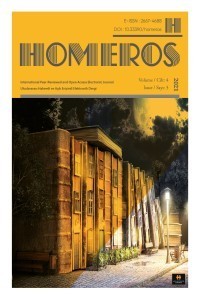THE REPRESENTATION OF DASEIN’S AWARENESS OF DEATH IN LOUIS DE BERNIÉRES’ NOVEL BIRDS WITHOUT WINGS
Throughout the human history, people have searched the ways of being different and unique. This quest has shaped various literary representations of uniqueness and especially in the postmodern period this concern gains more ground. Particularly, Heidegger’s theory of Dasein becomes most appealing, as Dasein’s difference and uniqueness emerges with his awareness. His level of awareness determines his status among ordinary people. His decisions and behaviours prepare him to become Dasein. The switch from everyday mode to authentic mode takes place through questioning. Authentic mode brings another level of awareness which establishes Dasein’s difference and characteristics. His awareness brightens his difference even in most terrific, outrageous situations such as the experience of death. This study focuses on Louis de Berniéres’ novel Birds Without Wings which depicts death as the most personal, unique and traumatic experience in one’s life. The novelist reveals how this trauma, experienced by his characters, leads to great suffering and pain. Using Heidegger’s perspective, Louis de Berniéres depicts Dasein’s difference during this experience. His awareness of his fragmentariness and his acknowledgement of his loneliness in this universe thwart the attempt to complete himself. This fragmentariness makes him Dasein. It is the reason that he accepts and embraces death of others. On another level, he embraces his own death, death of the self. This study considers mostly Georgio P. Theodorou from Birds Without Wings, a character who is beyond limitations as a Dasein, as he grasps the meaning of death and makes the readers aware of his dying process. His awareness of nothingness comforts him in the process of dying and allows him to be conscious during this process.
THE REPRESENTATION OF DASEIN’S AWARENESS OF DEATH IN LOUIS DE BERNIÉRES’ NOVEL BIRDS WITHOUT WINGS
Throughout the human history, people have searched the ways of being different and unique. This quest has shaped various literary representations of uniqueness and especially in the postmodern period this concern gains more ground. Particularly, Heidegger’s theory of Dasein becomes most appealing, as Dasein’s difference and uniqueness emerges with his awareness. His level of awareness determines his status among ordinary people. His decisions and behaviours prepare him to become Dasein. The switch from everyday mode to authentic mode takes place through questioning. Authentic mode brings another level of awareness which establishes Dasein’s difference and characteristics. His awareness brightens his difference even in most terrific, outrageous situations such as the experience of death. This study focuses on Louis de Berniéres’ novel Birds Without Wings which depicts death as the most personal, unique and traumatic experience in one’s life. The novelist reveals how this trauma, experienced by his characters, leads to great suffering and pain. Using Heidegger’s perspective, Louis de Berniéres depicts Dasein’s difference during this experience. His awareness of his fragmentariness and his acknowledgement of his loneliness in this universe thwart the attempt to complete himself. This fragmentariness makes him Dasein. It is the reason that he accepts and embraces death of others. On another level, he embraces his own death, death of the self. This study considers mostly Georgio P. Theodorou from Birds Without Wings, a character who is beyond limitations as a Dasein, as he grasps the meaning of death and makes the readers aware of his dying process. His awareness of nothingness comforts him in the process of dying and allows him to be conscious during this process.
___
- BERNIÉRES, L.D., (2004), Birds Without Wings, London: Vintage.
- BOHR, N., (2017), “Existentialism: Heidegger on Dasein and Death” [Online],LinkedIn, Retrieved from https://www.linkedin.com/pulse/existentialism-heidegger-dasein-death-nicole-czerwinski?trk=portfolio_article-card_title
- BAUDRILLARD, J., POSTER, M. (2001), Selected writing,. Cambridge, UK: Polity Press.
- FOUCAULT, M., (1991)., The order of things: An archaeology of the human sciences. London, FA.
- DERRIDA, J., (1995), Gift of death. University of Chicago Press.
- HEIDEGGER, M. (2013)., Being and time, United States: Stellar Books.
- HEIDEGGER, M.,(2014), What is metaphysics?, Siavash Jamadi Translation, Phoneix Publishing.
- HAN-PILE, B. (n.d.). (2010). The “Death of Man”: Foucault and Anti-Humanism. Foucault and Philosophy, Retrieved from doi: 10.1002/9781444320091: 118-142.
- KEARNEY, R., (2005), Strangers, Gods and Monsters: Interpreting Otherness, Routledge Taylor & Francis Group.
- NAGEL, T., (1970), The Possibility of Altruism, Princeton.
- NAGEL, T.,(1979), ‘Death’, Mortal Questions, Cambridge: 1–10.
- NAGEL, T.,(1986), The View from Nowhere, Oxford.
- OLEARY, T., & Falzon, C.,(2010), Foucault and philosophy, Chichester, U.K: Wiley-Blackwell.
- ROTH, P., (2001), Shop Talk: A Writer and His Colleagues and Their Work. Boston: Houghton Mifflin.
- SHARIATINIA, Z. (2015), Heidegger’s ideas about death[Online], (Volume 1, Issue 2), Pacific Science Review B: Humanities and Social Sciences, Retrieved from https://doi.org/10.1016/j.psrb.2016.06.001.
- YALOM, I. D., (2008), Staring at the sun: Overcoming the Terror of Death, Print.
